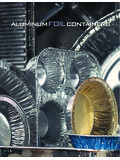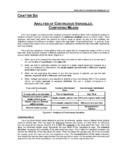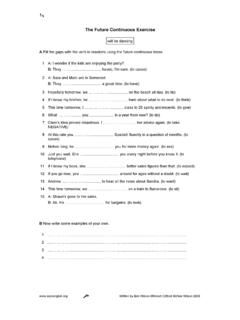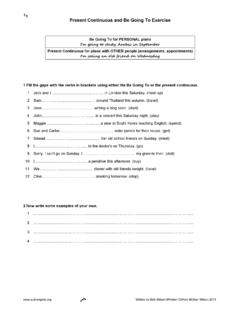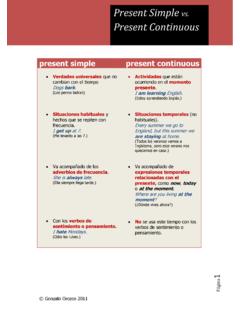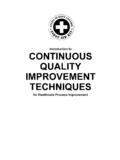Transcription of 3210 Continuous casting of Aluminium - afcma.org
1 Return to Table of Contents SUPPLEMENT 3. TALAT Lecture 3210. Continuous casting of Aluminium 27 pages, 23 figures Basic Level prepared by Dr. Ing. Catrin Kammer, Goslar Objectives: This chapter gives an overview about the possibilities to produce Aluminium foilstock and wire-bar in a Continuous way. Continuous casting is the preferred casting method in modern plants because it offers higher productivity. But there are limitations in the use of this technology because not all alloys can be cast. The product show properties that can differ from conventional material. The chapter will show - the principal of operation - technologies for Continuous casting - types of casters - areas of application - properties of the products - behaviour of the products in further processing Prerequisites: - General knowledge in materials engineering - Some knowledge about Aluminium alloy constitution and heat treatment - Engineering background in manufacturing processes - Basic knowledge of foundry practice Date of issue 1999.
2 European Aluminium association 3210 Continuous casting of Aluminium Contents 3210 Continuous casting of Aluminium .. 2. 3. Strip 3. Wire bar 5. Distinguishing features of Continuous casting technologies .. 6. Twin drum casters .. 9. Vertical casting direction .. 9. a) Vertical downward - Hazelett Sr. (1930 1940).. 9. b) Vertical upward - Hunter 9. Casters with horizontal casting 10. a) Scal, Alusuisse I, Jumbo 10. b) The development of the Jumbo 3C to the Jumbo 3CM thin roll caster .. 12. c) casting direction at an angle - The FATA Hunter SpeedCaster .. 13. Single drum 14. Block casters .. 15. Hunter-Douglas (Block caster) .. 15. Alusuisse Caster II .. 16. Belt casting techniques .. 16. Hazelett Caster .. 16. Kaiser 17. Casters with a combination of a rotating steel belt and a water-cooled casting 19.
3 Properzi-Caster .. 19. The Rigamonti and the Rotary 20. Structure and properties of strip castings .. 20. Behaviour of strip castings in further processing (rolling, thermal treatment) .. 22. Cold rolling .. 22. Deep drawing .. 24. Recrystallization .. 24. 26. List of 27. TALAT 3210 2. Introduction Due to its many economic advantages the Continuous casting of Aluminium has become more and more important during the last 40 years. These processes are mostly used for the production of a semifabricated strip, for cold rolling to foilstock building sheet and canstock. They are also used to cast endless wire bar stock. Continuous casting processes converts molten Aluminium alloys directly into an endless coiled strip suitable for cold rolling or wire-bars for wire-drawing. They effectively eliminate the operations associated with traditional mould casting (discontinuous process) or casting (a semicontinuous process) and subsequent hot mill deformation.
4 Therefore the capital investment and operational costs are significantly lower than in a conventional production process. Continuous casting is the preferred casting method in many modern plants because it offers higher productivity. Continuous casting has been employed with increasing commercial success for Aluminium as well as other metals. Among the Continuous casting technologies the strip casting processes now account for a remarkable share of the worlds output of rolled Aluminium semifabricated coilstock (approximately 30%). While strip casting will be the main topic of this chapter, the technology for the production of wire bar will also be described. Semicontinuous processes (DC casting ). are discussed in Lecture 1301. Strip casting Continuous strip casting has proved itself for the production of foilstock, of strip for painting and in some cases of strip for deep drawing processes.
5 The various strip casting technologies are suitable for the casting of wrought alloys and allow the production of strip from 3 mm to 20 mm thickness and up to 2150 mm width. Figure illustrates the main feature of all Continuous casting processes. Molten metal enters the casting mould (in Figure , the space between two rolls), solidifies there and leaves the mould as a Continuous strip. After casting the strip can be directly coiled or it can be immediately (without down cooling) rolled into a coilable gauge. For the mass production of collapsible tubes and rigid cans the machines for the blanking of slugs or for extruding can be placed directly after the casting machines. In this way a Continuous production is achieved. TALAT 3210 3. casting nozzle drum 1. molten solid strip metal drum 2.
6 Solidification alu Principle of Continuous casting (for a twin drum caster) Training in Aluminium Application Technologies The conventional way of producing rolling slabs is DC (Direct Chill) semi- Continuous casting although some slabs are produced by pouring molten metal into a permanent mould. After DC casting , the rolling slabs are re-heated to about 500 C and hot rolled to a coilable thickness between 4 mm and 6 mm. The biggest advantage of the Continuous technologies is the saving of several production steps in the production of strip or foil compared to conventional technologies. Conventional technology: Melting DC- casting hot rolling coiling cold rolling (possibly including several thermal treatments) foil or canstock Continuous technology: Melting strip casting coiling cold rolling (possibly including several thermal treatments) foil or canstock This saving of production stages includes several other advantages: compared with the conventional way, processing costs are only a third to a half as high, operating and investment costs are only a quarter to a third as high and there are smaller space and labour requirements.
7 Less energy is required because it is no longer necessary to preheat the ingot before hot rolling. The productivity is 15-20% higher; the material consumption is - 2% lower. Newer developments, such as those made by Pechiney and FATA Hunter, enable very thin strip to be produced (< 3 mm thick). This leads to even less rolling stages, when producing thin foil or beverage canstock. When Continuous casting was first introduced it appeared to have many advantages which result to production economies. However it soon became obvious that the technology introduced some features in the finished product that limited its use compared with conventionally produced material. Foilstock however in particular lends itself to the Continuous strip route. TALAT 3210 4. The most serious of these disadvantages is the difficulties that exist in casting alloys with high alloy content.
8 Due to the wide freezing range of these alloys there is a danger of cracks in the strip. If not all the metal is solidified at the narrowest point of the casting machine, liquid or semisolid metal can leave the casting mould. It is possible to avoid this with a lower casting rate, but even this solution is limited because, if the casting rate is too low, it is possible to have solidification in the direction of the casting nozzle. In consequence, the casting rate of alloys is lower than that of commercially pure Aluminium . Therefore only alloys with a low alloy content can be cast, for example Commercially pure Aluminium to Al (series 1000);. AlMn (max. 2% Mn, Series 3000);. AlMg (max. 2 to 3% Mg, exception Alusuisse Caster II with max. 5%. Mg, Series 5000), AlFe (max. 2% Fe) or AlMnFe (max.)
9 1% Fe, max 1% Mn). It is important to note that in any comparison of the output rate of different Continuous casting processes, it is necessary to compare the production of the same alloys. Usually the various strip casting technologies are divided according to the dimensions of the finished product into processes for wide strip casting (width up to 2150 mm), for narrow strip casting (maximum width 800 mm). for strip, that can be coiled immediately after casting (gauge max. 10. mm), for strip to be hot rolled after leaving the casting machine (gauge between 20 mm and 40 mm). for thin gauge casting (gauge under 3 mm). Another distinguishing feature is the type of the caster (see chapter 3). Wire bar casting The Continuous casting of wire bars is also of great economic importance.
10 As is the case for strip casting some production steps are saved. For the alloy content the same limitations obtain. That is why mainly commercial pure Aluminium is cast. Other alloys eg AlMn and AlMgSi (Aldrey) are produced. All these materials are although used in electrical engineering. TALAT 3210 5. Distinguishing features of Continuous casting technologies The Continuous casting technologies can be divided by processes into horizontal or vertical casting direction. And by mould type fixed or mobile walls. In the later case the walls are moving with the molten metal, while the walls are motionless in the former. Fixed walls are not used for industrial production and are not a topic of this lecture. Today five types of casters for Continuous casting of Aluminium are used.
